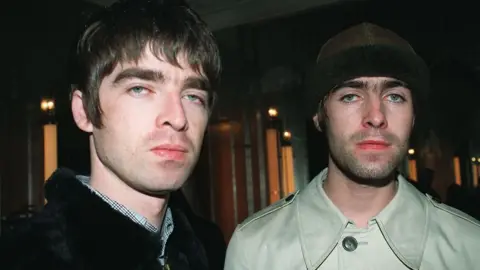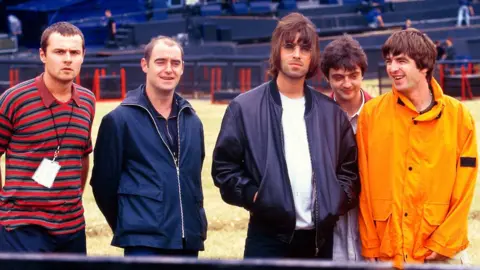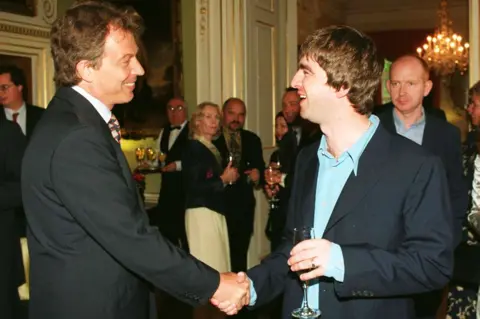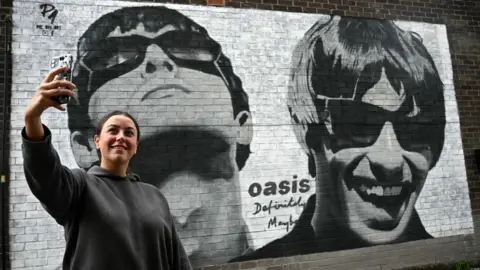Why do we care so much about Oasis?
 PA Media
PA Media"He’s like a man with a fork in a world of soup."
Noel Gallagher’s glorious quote about Liam in April of 2009 was perhaps a sign that even the notoriously combative brothers might have a breaking point.
It came four months later, in a particularly bad-tempered gig in Paris (August seems to be the month of all the major Oasis moments). No one was very surprised when Noel finally walked out - even at their peak, the friction was part of their fame.
Oasis were more than just a massively popular band, they were a soap opera with two of rock and roll’s most charismatic combatants.
A recent eight-part BBC podcast about the rise and fall of Oasis was divided up, not by albums or tours but eight famous fights.
 Getty Images
Getty ImagesIt is, however, worth remembering just how famous they were.
For anyone who either did not live through it or went out of their way to avoid it, Oasis were, at their peak in the mid-90s, almost inescapable.
What’s the Story (Morning Glory) was the biggest British album of that decade, selling five million copies in the UK and 22 million worldwide.
Thirteen years before their fractious finale in 2009, they were in August of 1996 at the height of their imperial phase. Over two nights, 250,000 watched them headline at Knebworth in what was the high water mark of Britpop.
The rest of the bill: Manic Street Preachers, The Prodigy, The Charlatans, The Chemical Brothers, Ocean Colour Scene, Cast, were just that - the rest of the bill.
In February 1996, Oasis performed Don’t Look Back in Anger and its B-side - a cover of Slade’s Cum on Feel the Noize - on Top of the Pops, making them one of the only bands to perform two songs in one episode in the show's history.
And in the newspapers, they appeared almost every day.
 PA Media
PA MediaWhen Tony Blair won a landslide victory in 1997, he held a celebratory drinks reception at Number 10.
The photograph of him, smiling, shaking hands with an equally cheery Noel Gallagher became the defining image of that short lived honeymoon, Cool Britannia - a surge of pride in British culture in the late 1990s.
"I was 30, off me head on drugs, and everyone telling me we were the greatest band since who knows," Noel recalled. "Then the prime minister invites you round for a glass of wine. It all becomes part of the high.
- Fans react to 'massive' news of Oasis reunion tour
- Oasis tickets and everything you need to know about the reunion tour
This was the last hurrah of pre-internet culture when prominence on the charts, TV and newspapers was a guarantee that pretty much everyone in the country, whether they liked you or not, would know about you.
Noel was right when he said: "You have to see us in league with The Rolling Stones now. Everybody’s heard of the Stones, everybody knows what they sound like, everybody knows what they do."
There was only one direction it could go.
When the band began work on their next album, Be Here Now, What’s The Story (Morning Glory) was still at number five in the US Billboard Chart.
When it was released in August of 1997, the initial excitement quickly subsided. What is perhaps remarkable is that they managed to stay together so long.
 Getty Images
Getty ImagesWhen Noel was asked about the idea of an opera about Oasis he said: "I don’t think two blokes having the same argument for 16 years over and over is the stuff of opera. Oasis: The Opera would be very short."
But even at their most fractious, they were still a force.
Watching them at Glastonbury in 2004, I remember even those who had just turned up out of curiosity knew all the words. In an age of Spotify and private playlists that doesn’t really happen in quite the same way.
"You can’t get bored of 15,000 people shouting for Wonderwall. That’s better than drugs," as Noel put it.
Now 15 years on, Oasis have staged another August moment - looking forward to August of 2025.
The 250,000 fans from Knebworth in 1996 are now in their 40s and 50s but plenty have managed to pass on some of their fervour to their children.
There are many 20-somethings who know all the words to Wonderwall, but to get there, we need 12 months without a major falling out.
A wary fan might be best trying to get tickets for one of the early dates of the tour.
